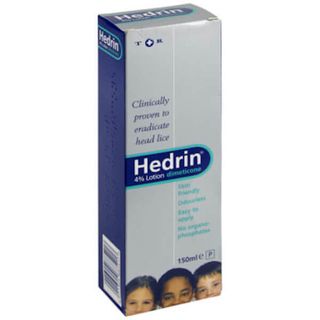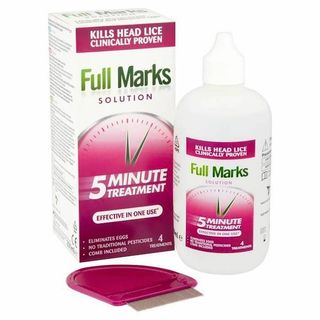
Head Lice
The scourge of young families, and anyone who has close contact with children, head lice make your scalp infuriatingly itchy. Contrary to popular belief, there’s no link between infestations of head lice and dirty hair, but they are easily transmitted through hair-to-hair contact, which is why they’re so common in young children. You can treat head lice at home using a medicated lotion and a fine-toothed comb. Tackling the bugs as quickly as possible will make it easier to evict them from your scalp and help to stop them finding another home nearby.
Head Lice Treatments
 Hedrin 4% Lotion£13.49
Hedrin 4% Lotion£13.49- Out Of Stock

Full Marks Head Lice Solution
Full Marks Head Lice Solution£10.99
View recommended products for Head Lice
Don't wait to get the medical help you need.
View our recommended treatments and select your preferred treatment and quantity from a list of options for you.
- Selected by our UK-based medical team
- Quick and easy checkout
- Treatments dispatched same day (before 3pm)
Ordering as easy as 1, 2, 3
1. Find the ideal treatment
2. Get a free consultation
3. Enjoy speedy delivery
Advice for Head Lice
What are Head Lice?
Head lice are small white, grey or brown insects that live in human hair and are particularly common in children of school age. They are notorious amongst parents as they can spread quickly between children through head-to-head contact, they do not fly, swim or jump and can only be transferred by touching hair with someone who already has head lice.
Head lice are not a result of poor hygiene or dirty hair. They actually prefer clean hair as it is easier to move through, although they will infect any type or length of hair. Head lice can normally be found at the root of the hair and grow roughly to the size of a sesame seed.
Life Cycle of Head Lice
Female head lice lay eggs (nits) at the root of hair by cementing them to the scalp. The eggs can be difficult to spot as they are extremely small.
Head lice eggs hatch after 7 – 10 days releasing the baby head lice, which then feed on the scalp and grow to full size in around 10 days. They leave the white empty eggs (now known as nits) attached to the hair that grows out with the hair and becomes more noticeable.
Female head lice can start laying eggs from 9 days old so they need to be removed from the scalp before this point to break the infection cycle.
How do I know if I have Head Lice?
Head scratching is normally the symptom that leads to the discovery of head lice. However, the itching caused by head lice is due to an allergy to the lice, which not everyone has and even if they do it can take up to three months to develop.
Children of school age should be inspected for head lice regularly as well as parents looking out for warnings from their school that head lice may be spreading.
As head lice are only the size of a sesame seed when fully grown, they can be difficult to spot. This is not helped by their normal brown/grey colour helping them to blend into the hair. The best method to check the hair for head lice is detection combing using a fine-toothed head lice comb (like Nitty Gritty).
Detection combing can be done on wet or dry hair, although it tends to work better on wet hair. It traps lice and pulls them out of the hair to allow easy identification and diagnosis. To diagnose an active infestation you must find live head lice, eggs/nits are not enough as these can be dead and left attached the hair after the actual lice infestation has cleared.
See ‘Wet Combing’ in the ‘Treatment’ section below for advice on combing using a fine-tooth nit comb. This can also be done with dry hair although it is usually easier and more effective if the hair is wet.
How do I treat Head Lice?
Head lice are notoriously difficult to treat as they have an extremely high re-infestation rate, especially amongst school children. Combined treatment of wet combing and a head lice lotion or spray can prove effective, however preventative measures must also be put in place to prevent recurrence.
Treatment for head lice now favours using oil or silicone-based products (such as Hedrin) as traditional insecticides now have a high rate of resistance and are becoming less effective.
Remember you should only start treatment if lice head lice are found; eggs/nits alone are not enough to diagnose a head lice infestation.
A typical treatment regime for treating an active head lice infestation is:
Wet Combing
- Wash the hair using plenty of shampoo, apply generous amounts of conditioner and brush through using a normal comb
- Systematically work through the hair using a detection comb by placing the bevel-edge lightly against the scalp and drawing the comb all the way down to the end of the hair
- Check the comb between each stroke and rinse off and head lice that may be present
- Rinse out the conditioner and repeat the detection combing procedure
- Repeat this procedure every 3 days for at least 2 weeks to remove newly hatched lice before they can lay eggs
Head Lice Lotion/Spray
Head lice lotions or sprays are the best over-the-counter treatments for head lice and can be used in combination with wet combing to fully treat an infestation. Rinses and shampoos are generally not as effective.
You should ensure you have enough to treat everyone who has a confirmed infestation, taking in account the length and type of their hair. They are normally applied to dry hair and left on for between 10 minutes and 8 hours. You should check the individual products for specific usage instructions.
Head lice treatments do not always kill the eggs so it is normally advised to repeat the application after around 7 days. You should check for live lice around 3- 5 days after using the treatment and again after 10 -12 days although if you are also wet combing this will not be necessary.
It is not normally necessary to see your GP for head lice treatment although persistent infestations may need to be investigated. It is not normally advisable to treat babies under 6 months old, pregnant women or people with asthma or allergies without consulting a healthcare professional.
FAQs for Head Lice
How are head lice caught?
Head lice crawl from one person’s hair into another’s in close proximity. Head lice do not jump or fly. What’s the best way to detect head lice? Regular examinations using a nit comb like Full Marks Detector Comb or Nitty Gritty comb. Check for head lice if anyone in your family has been in contact with someone who has head lice
Why do head lice cause itching?
The thought of head lice alone is enough to make some people itch. Others develop an itching sensation when the louse injects salvia into the scalp while it feeds. This itch can take weeks to develop or not develop at all.
What are nits?
Nits are white, empty egg shells that the louse leaves behind when it hatches. They stick to the hairs and can be removed with a nit comb or a pair of tweezers.
Will shampooing remove head lice?
Ordinary shampoo will not remove head lice. This is because the lice breathe through holes in their bodies called spiracles. During a regular shampoo, they simply close these spiracles until the washing stops, making the shampoo ineffective at killing them.
What if I have asthma, eczema or sensitive skin?
Full Marks Solution is suitable for people who suffer from eczema and asthma, but speak to your doctor or pharmacist for more advice. Derbac M is suitable for use by asthma sufferers and is appropriate for sensitive skin.
How can I prevent my children from getting head lice?
You can’t prevent children from contracting head lice, but with regular detection combing you can find head lice quickly and destroy them before their population grows.
How quickly could I catch head lice after a successful treatment?
Relapse can happen immediately as treatment doesn’t prevent head lice from being caught. For this reason, ‘contact tracing’ is important since it reduces the chance of immediate relapse.
Do I need to tell anyone if I find a head lice infestation?
You should conduct ‘contact tracing’ if head lice is caught and inform close relatives, friends and your child’s school. However, your child does not need to miss school while being treated for head lice.